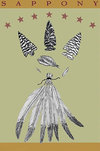Sappony facts for kids

Official logo of the Sappony
|
|
| Named after | Saponi people |
|---|---|
| Type | state-recognized tribe, nonprofit organization |
| Legal status | Trade associations; business and community development organization; arts, culture, and humanities nonprofit, chariy |
| Purpose | A23: Cultural, Ethnic Awareness |
| Location | |
|
Membership
|
850 |
|
Official language
|
English |
|
Executive Director
|
Dante Desiderio |
|
Treasurer
|
Charlene Martin |
|
Revenue (2019)
|
$96,996 |
| Expenses (2019) | $54,912 |
|
Formerly called
|
Indians of Person County |
The Sappony are a Native American group recognized by the state of North Carolina. They believe they are descendants of the historic Saponi people. The Saponi were an Eastern Siouan language-speaking tribe. They lived in the Piedmont areas of North Carolina and Virginia long ago.
The Sappony were once known as the Indians of Person County. Their main community is in Roxboro. This city is the county seat of Person County, North Carolina.
It is important to know that the Sappony are not recognized by the United States federal government. They have also not asked for this federal recognition.
Contents
What is a State-Recognized Tribe?
A state-recognized tribe is a Native American group that a state government officially acknowledges. This is different from federal recognition. Federal recognition means the U.S. government officially recognizes a tribe.
State recognition can give tribes certain rights and benefits within that state. It also helps preserve their culture and history.
How the Sappony Tribe is Organized
The Sappony tribe has a formal organization. In 1996, they created a special group called the High Plains Indians. This group is a 501(c)(3) nonprofit organization. This means it works for public benefit and does not aim to make a profit.
Who Leads the Sappony Tribe?
The Sappony tribe has leaders who help manage their community. In 2021, some of the main leaders included:
- Otis K. Martin, who was the tribal chief.
- Dorothy Stewart Crowe, who was the board chairperson.
- Charlene Y. Martin, who served as the treasurer.
- Juila Martin Phipps, who was the secretary.
- Danta Desiderio, who was the executive director.
These leaders help make decisions for the tribe. They also work to support the community.
See Also

